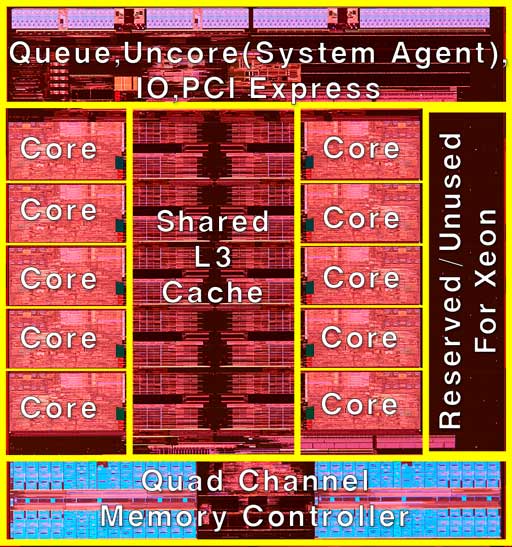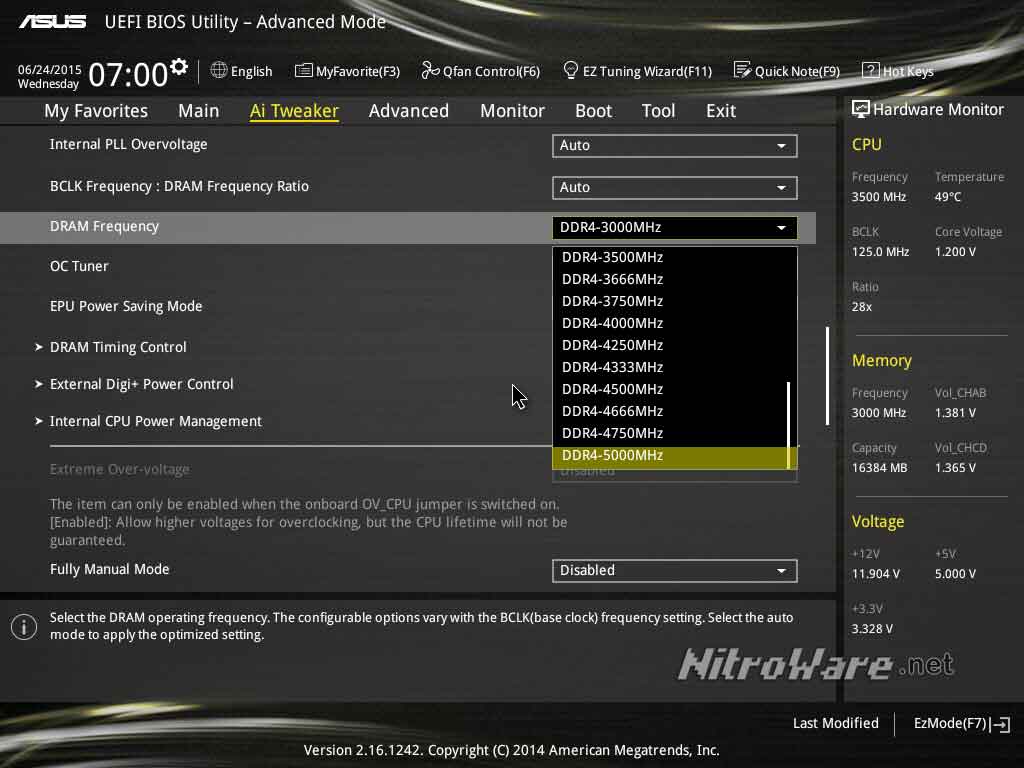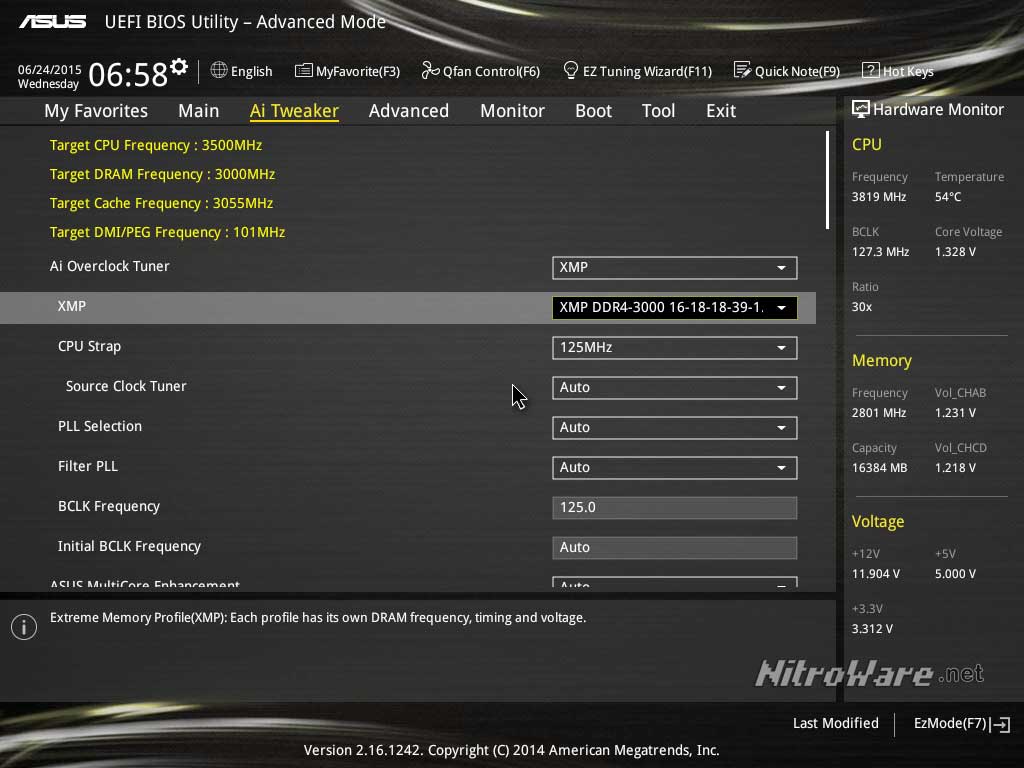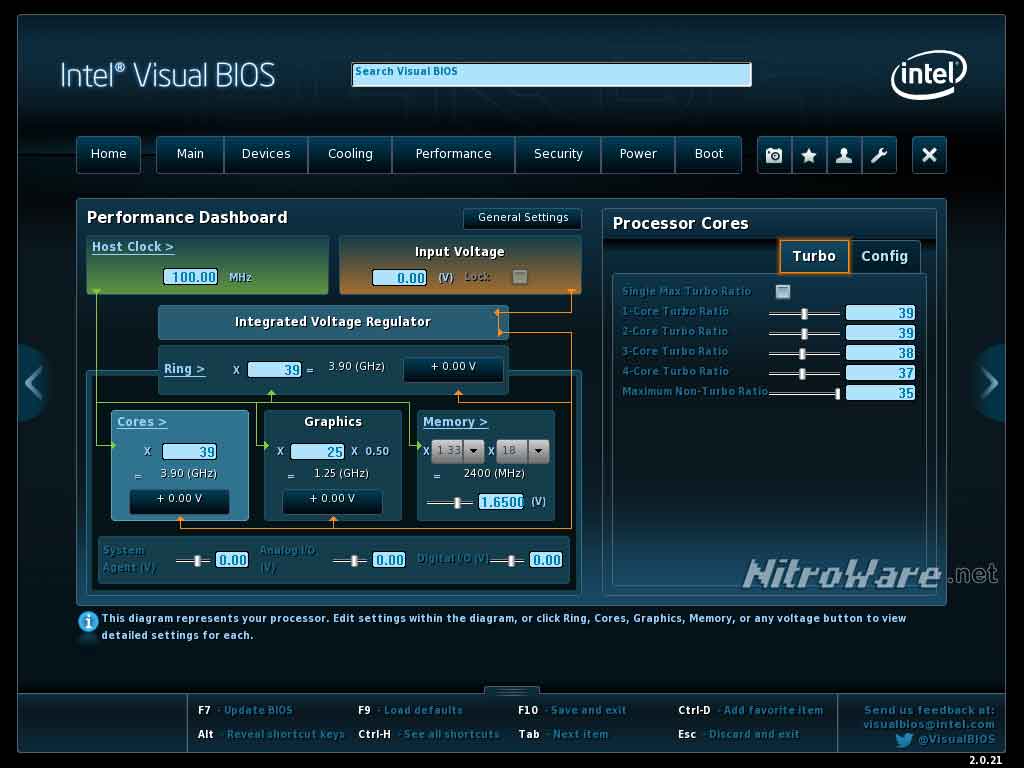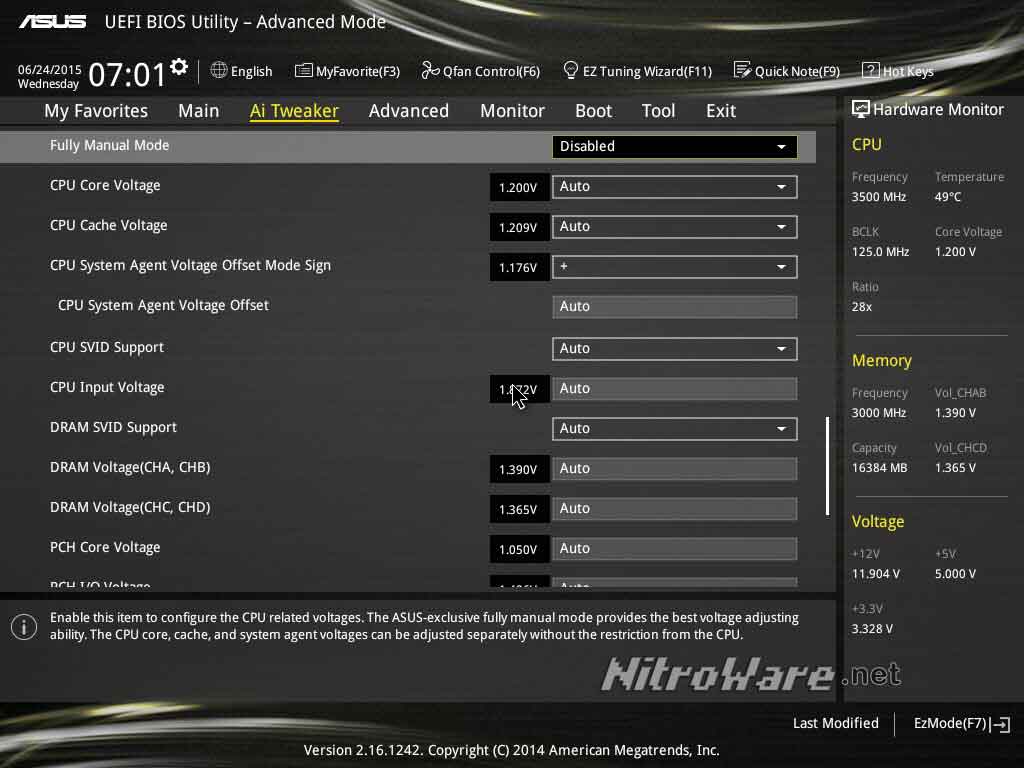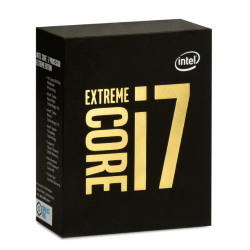 Featuring Australian, Euro and US Pricing
Featuring Australian, Euro and US Pricing
At $1569 US RRP ($2600 AUD street), the i7 6950X may be Intel’s most expensive consumer processor ever.
While the market is slowly getting used to expensive graphics cards and has been used to expensive server processors which can cost up to $5000 each, the concept of a ultra-enthusiast/high-end consumer CPU exceeding US$1000 has hit a sore nerve with some users.
For the launch of Intel’s latest extreme edition CPU, we discuss why the new flagship i7 costs the same as a crappy used car and what benefits it brings to the new trend of ‘mega-tasking’, plus we explain what is probably the key new feature for Broadwell-E, Turbo Boost Max Technology 3.0.
Specifications
Utilising 14nm Tri-Gate 3-D Transistors (Intel’s own tradename for industry-wide FinFet Transistors), the firm has added two to four additional cores across most of its Xeon E5 version 4 product stack (Codename Broadwell-EP) and to the flagship i7 for this generation, the 6950X (Codename Broadwell-E) while maintaining the same 140-watt TDP and clock speeds.
 Meet the family, almost fifteen years of high end Intel Processor Technology. Intel claims the strange looking heat spreader on Broadwell-E/EP is due to the need to fit the large number of cores possible using their 14nm manufacturing process.
Meet the family, almost fifteen years of high end Intel Processor Technology. Intel claims the strange looking heat spreader on Broadwell-E/EP is due to the need to fit the large number of cores possible using their 14nm manufacturing process.
For Haswell-E, we had three parts launch and for Broadwell-E in 2016 we have three parts launch which supercedes the existing Haswell-E chips directly, plus the new 10 core flagship.
| Date | Model | Base Speed (GHz) | Max Turbo Boost Speed (GHz) |
Cores/ | Cache |
PCIe Lanes |
Memory | Intel MSRP $ USD |
|---|---|---|---|---|---|---|---|---|
| Q2’2016 – NEW | Core-i7 6950X | 3.0 | 3.5 | 10/20 | 25MB | 40 | DDR4-2400 | 1569 |
| Q2’2016 – NEW | Core-i7 6900X | 3.2 | 3.7 | 8/16 | 20MB | 40 | DDR4-2400 | 999 |
| Q3’2014 | Core-i7 5960X | 3.0 | 3.5 | 8/16 | 20MB | 40 | DDR4-2133 | 999 |
| Q2’2016 – NEW | Core-i7 6850K | 3.6 | 3.8 | 6/12 | 15MB | 40 | DDR4-2400 | 587 |
| Q3’2014 | Core-i7 5930K | 3.5 | 3.7 | 6/12 | 15MB | 40 | DDR4-2133 | 583 |
| Q2’2016 – NEW | Core-i7 6800K | 3.4 | 3.6 | 6/12 | 15MB | 28 | DDR4-2400 | 412 |
| Q3’2014 | Core-i7 5820K | 3.3 | 3.6 | 6/12 | 15MB | 28 | DDR4-2133 | 389 |
A disclaimer on the 'Base Speed' listed in this table. It is the processor's minimum advertised speed and not activated in typical use. We explain why later in this review.
6950X is the first ten core consumer CPU on the market (AMD’s FX enthusiast processor which uses a shared core design is still at 8) and apart from this fact, 14nm Tri-Gate and a slight clock increase across the i7, Intel have added a few knobs and dials to make the new product a little more appealing to the power user community.
DDR4-2400 support
This is not that important in the grand scheme of things unless one intends to put these processors into an OEM machine or board that does not support high memory speeds. All third party X99 motherboards from name brand manufacturers do support high-speed memory and DDR4-2400 already worked fine on Haswell-E, let alone speeds up to and past DDR4-3000.
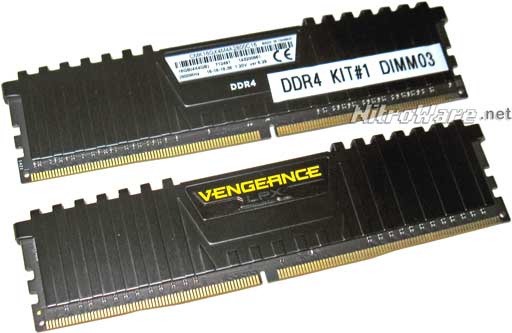 DDR4-2400 is widely regarded as the ‘new’ minimum speed versus what we had in 2014 being DDR4-2133.
DDR4-2400 is widely regarded as the ‘new’ minimum speed versus what we had in 2014 being DDR4-2133.
A caveat with Haswell-E and X99 was that different speeds of memory required the base clock to be increased so that the right memory speed such as 2800 or 3000 could be setup. Increasing the base clock also increases the clock speed slightly, and this is technically an overclocked state which is not officially supported by anyone involved.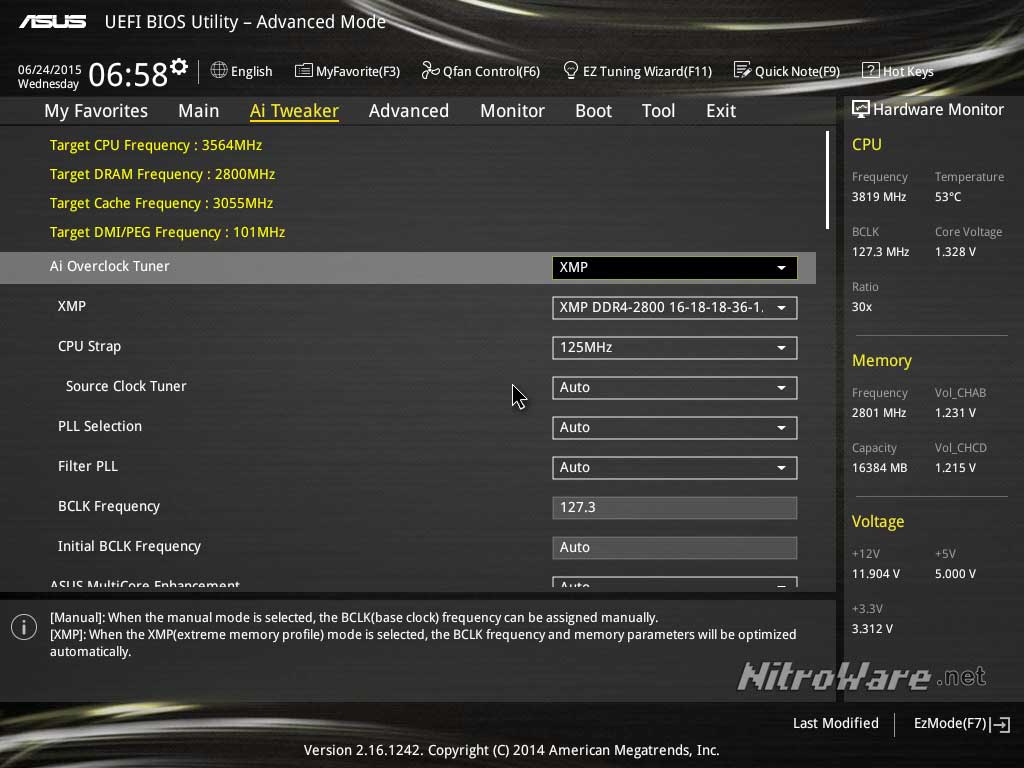
We reached out to Intel who told us that Broadwell-E was no different and still incorporated the same memory straps/bus dividers. Given Intel changed the memory support, we will have to confirm this for ourselves. Skylake in its quad-core format paired with Z170 does not have this restriction.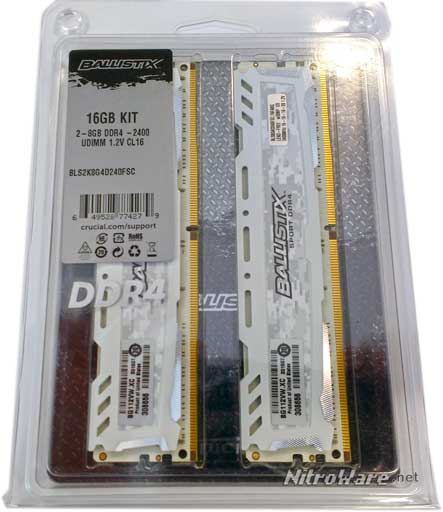
Per-Core Overclocking
According to Intel’s Platform Marketing Manager for Extreme Edition,Haswell-E had ganged multipliers, meaning one adjustment affected all the cores, yet now Broadwell-E has per-core overclocking.
This did not make sense, and checking the X99 boards we had access to as well as Intel’s own Z87 board right there plain as day are per-core ratio settings for the user to fine tune their settings.
All I have to say is WTF? I was not mistaken, we have a slide plus a conference call where this information was relayed.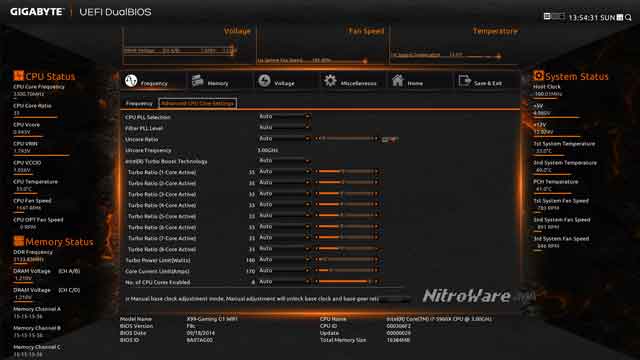
Looking further, the ability for the BIOS to adjust these settings adjustments are one thing but the actual turbo multiplier on the CPU is another thing, and that is what Intel was likely referring to. No clarification was provided and we had to find out for ourselves.
It turns out that on the higher core i7s, the ratios are largely the same/grouped as shown in our screenshots above and Broadwell-E is supposed to fix that.
Note in the below table how that if regardless if cores 3 to 8 are in use, the speed is 33x multiplier (33x 100 bus speed) or 3.3GHz, whereas on the other listed processors we have 3-speed tiers for the Ivy Bridge based Xeon and Haswell based i7. The setup on the 5960X is not the most efficient.
| Processor Model | Base Frequency (GHz) | Number of Active Cores Max Turbo Boost Frequency (GHz) | |||||||
|---|---|---|---|---|---|---|---|---|---|
| 1 | 2 |
3 | 4 | 5 |
6 | 7 | 8 | ||
| Core-i7 5960X | 3.0 | 3.5 | 3.5 | 3.3 | 3.3 | 3.3 | 3.3 | 3.3 | 3.3 |
| Xeon E5-2643v2 | 3.5 | 3.8 | 3.7 | 3.6 | 3.6 | 3.6 | 3.6 | ||
| Core i7-4770K | 3.5 | 3.9 | 3.9 | 3.8 | 3.7 | ||||
AVX Ratio Offset
Haswell-EP (Dual Socket capable Xeon E5v3) introduced double wide AVX-512 instructions. Because AVX is computationally intensive for the CPU, on that processor they reduce the clock speed only when software heavily utilising those instructions is run. By backing off on the speed, it reduces the max temperature and gives the processor headroom, preventing the CPU from reaching its thermal limiter and going into throttle mode, which will more severely affect performance.
An analogy is a car engine at high RPMs if it works constantly at the redline it can overheat or be damaged. Hence the role of the gearbox in the drive train.
Broadwell-E brings across the AVX Ratio offset feature from Haswell-EP to enable this functionality, however, does not introduce AVX-512 support. Haswell-E had neither of these features.
This feature is more something appealing to the enthusiasts and overclockers who understand how their CPU and software works in certain scenarios, however those who do very heavy content creation such as video transcoding, this feature will help by doing its work behind the scenes and ensuring that the processor does not end up throttling during these types of workloads, especially if there is an overclock applied which of course increases heat.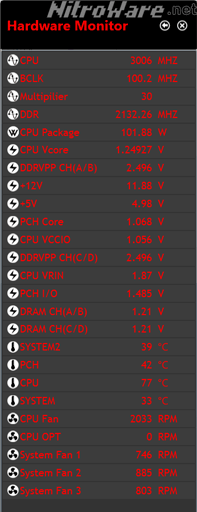
VccU Voltage Control
Like Haswell but unlike Skylake, Broadwell utilises an integrated voltage regulator to control and divide all of the particular voltage rails the processor needs to operate its various logic and function blocks. This technology is carried over from Haswell but was not used for Skylake
With a feature packed brand name X99 board, a full slew of knobs and dials are available to tweak the various voltages and performance of the CPU’s integrated voltage regulator.
Again like with the ‘per core overclocking’ options another WTF moment for us.
Again, during the conference call to brief us on these new processors, Intel talked about how the new VccU control ‘knob’ would allow the ring bus voltage to be increased and would be very beneficial to extreme overclockers using liquid nitrogen (Vcc is engineering notation for Voltage).
There are a few technical terms to clarify before continuing.
- System Agent – Also called the Uncore. Contains logic that is not related to the CPU Cores such as PCI Expres bus and Chipset Bus, Memory Controller and Graphics
- Ring Bus – An interconnect within the processor between the Cores, Cache, System Agent and Integrated Graphics (If Applicable)
Intel claims they added a new adjustment to allow the RING voltage to be increased.
Well, guess what, we checked a number of boards, both X99 for the Extreme Edition process and Z87 for mainstream processors and some already had this knob implemented.
Gigabyte clearly labels their knob as ring voltage, plus System Agent voltage, but no Cache voltage on the Gigabyte X99-Gaming G1 board.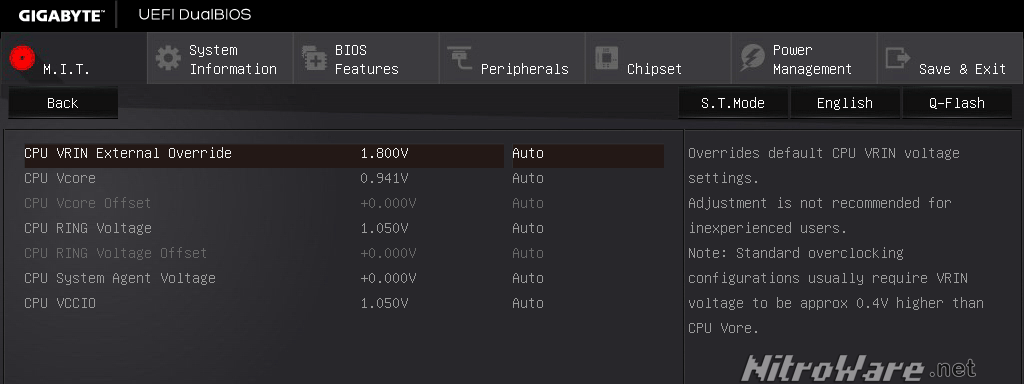
ASUS has more knobs, Cache, System Agent but no Ring Voltage on the X99-A/USB 3.1 board
Intel has System Agent and Ring Voltage on their DZ87 board, visible in our earlier screenshot
Different manufacturers use alternate names for different adjustments hence, the labels do not align between brands but we call a spade a spade, nothing engineering about it. If a vendor says something is new, yet it appears not to be at first glance then something is up.
Turbo Boost Max Technology 3.0
The most signficant feature with Broadwell-E we think is Turbo Boost Max Technology (TBMT), which deserves its own section, following.
Turbo Boost Max Technology 3.0
After many years, Intel has finally updated their turbo boost feature in their processors, which allows their chips to run at much higher clock speeds until certain power and temperature limits are reached. For X99 and Broadwell-E CPUs, a driver and software utility will allow users to target applications to run on the highest performance processor core, making the best and most efficient of individual CPU cores that have had their clock speed increased by the CPU’s Turbo boost feature.
To the best of our knowledge, this is purely a software override for Windows task manager and involves no hardware or firmware. The user could achieve a similar result using the existing windows controls but it would be too overwhelming to manage.
With Broadwell-E bringing little to the table (it does not have the updated graphics of desktop and mobile parts), Intel had to do something to enhance the appeal of the new Extreme Edition parts, especially as they are clocked lower than the popular mainstream i7-6600 and 6700K which can run up to 4.8GHz when overclocked.
Most of Intel’s modern processors since their 1st Gen Core-i series (Nehalem) have included turbo boost technology, a feature which allows the CPU clock speed to run higher and faster provided certain limitations such as time, power or heat are not exceeded.
Provided the processor is within these performance envelopes, it should run as fast as possible. AMD also provides similar technology but this story will focus on the Intel’s Desktop implementation. Turbo Boost is not available on cheaper processors such as Pentium or Core i3.
Turbo Boost 1.0 as implemented on 1st Gen Core provided a very small increase on desktop processors, clock speed could only step up a few bins/multipliers (steps)
Later processors with Turbo Boost 2.0 provided a larger boost in turbo performance, with up to 500 MHz increase for Desktop Processors, and for some mobiles 1GHz or more such as for Core-M CPUs. In this case, it was a practical feature out of the box, to provide that much performance increase and for overclockers, it was simply a dream as it provided an inside as to how much safe headroom a processor had for the user to overclock and push to or past that point.
Before we dive into what Turbo Boost 3.0 is, a few points need to be clarified for those who are not that in-depth into PC components and performance tweaking. In our travels, we have encountered individuals and companies who are still confused about Turbo Boost is
-
Regardless of the generation, Turbo Boost has nothing to do with ‘overclocking’. It is an out of the box, bullet-point marketing feature for the processor to provide extra performance. Some people incorrectly interpreted Turbo as the speed they could attain if they manually overclocked their system.
-
The clock speed that Intel advertises in its specs or on the box is the worst case or base clock, and the processor normally runs at higher speeds. This is illustrated in the below table
| Unlocked Processor Turbo Boost Speeds (GHz) | i7-3770K i7-6600K | I7-4770K | I7-4790K | i7-5960X i7-6950X |
|---|---|---|---|---|
| Uncore/Base/Advertised | 3.5 | 3.5 | 4.0 | 3.0 |
| All Core | 3.7 | 3.7 | 4.2 | 3.3 |
| Single Core | 3.9 | 3.9 | 4.4 | 3.5 |
| Multi Core Enhancement Option | => 3.9 | => 3.9 | => 4.4 | => 3.5 |
How to read the table.
The first row is the clock speed Intel advertises, eg ‘3GHz up to 3.5GHz with Turbo Boost’ it is also the speed that parts of the processor that are not the CPU cores, such as the Bus and the Cache run at, also called the ‘uncore’, i.e. not-the-core. The Speed is also the failsafe speed for when the processor decides to switch off turbo boost if the processor is overloading or overheating.
- The All core speed is the Turbo Boost Speed that the processor will run all the cores at with a heavy software load, providing no limits are met. For example, when encoding a video the quad-core parts will run at 3.7GHz or all Eight/Ten Core CPU model will run at 3.3 GHz
- The Single Core speed is the Turbo Boost speed that the processor will run a single core at when the software load is light and only needing that one core. For example, iTunes is largely single threaded and can only use one core, so the CPU will run one Core at 3.9 GHz and the other cores sleep at lower speeds.
- Most Z/X series motherboards meant for the unlocked Intel Processors will let the user override the Intel Turbo settings, sometimes by default. This means the board will run all of the processor cores at the maximum turbo speed depending on the model, eg 3.9GHz, 4.4 or 3.5GHz all core. This provides a boost in performance over the Intel settings at the expense of slightly more heat and power draw. On top of this, the user may overclock their unlocked processor in any mode, and can run say at 4GHz all core if they wish. This is often called MCE/Multi Core Enhancement by the board vendor.
The addition of Turbo Boost max 3.0 software is to control which apps and in what priority those apps use the faster cores as described in point 3.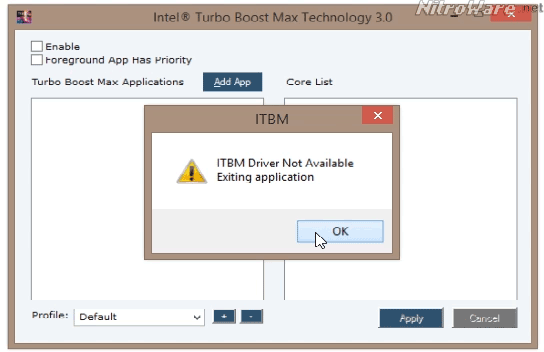
Applicable only for the X99 chipset motherboard platform, and likely locked initially to Broadwell-E. Turbo 3.0 includes a device driver and application for 32/64bit Windows (32bit, really?? 32bit is useless for any modern performance platform) to prioritise and control which applications are executed on the CPU’s fastest core.
This software is not for 6th Gen Skylake as it will not install on Skylake/Z170. Besides, there has been no advertisement of Turbo 3 for 6th gen. There is a possibility that after Broadwell-E launches Skylake may receive this software if Intel are generous and there are no major changes in the CPU’s thread scheduler or programmable areas. Kaby Lake likely then? Get onto it Intel…
What is not clear here is whether Turbo Boost Max Technology 3.0 is simply the release of this utility for enthusiasts, with the underlying hardware unchanged and still compliant with Turbo Boost 2.0, or if the is an underlying hardware change and the operation of turbo boost and how the clock speed of individual cores within the CPU has changed. Intel would not elaborate.
What is clear though is that there is still confusing to users and in the marketplace about what turbo boost is, which CPUs support it and how it really works. This is something vendors need to address quickly.
On face value, this utility is somewhat of a gimmick as I don’t see heavy adoption. Those who would want to tweak and tinker would likely have engaged all-core overclocking anyway, which synchronises the same maximum speed to all cores, rather than prioritising a few cores which are the default behaviour. In fact, some motherboards will enable synchronous all-core overclocking automatically when XMP memory is enabled.
As a power user/enthusiast/overclocker/professional idiot, I personally have little use for the Turbo Boost 3 software and I think many other enthusiasts would not either. Boards from ASUS and MSI will automatically run the CPU at all core turbo, usually when the XMP memory profiles are enabled, making all the cores run at the same synchronised speed and making the Turbo 3 utility useless in this scenario.
Intel should take this technology and, enhance, evolve and refine it and integrate it into Windows so that future CPUs can benefit, rather than a box marketing bullet point which many will not use.
Performance Benchmarks
Foreword
Benchmarks of the actual new CPUs? Fuggitaboutit! For this actual review we have to subsitute in our archival benchmarks and data from Haswell-E/5960X and historical information,data from several X99 platforms we have tested.
When embargo along with the specs on the new processors, Intel provided some numbers which make certain performance claims. The policy of this website is we will no longer be a proxy for a vendors ‘manipulated’ performance and marketing claims, which are achieved under very specific conditions.
We either reproduce performance results ourselves using a review sample, which is typically issued to media for this purposes or we will not discuss marketing performance numbers at all.
The role of the independent media is not to be a sock puppet, proxy or copy and paste machine for big corporate. Independent media must objectively report on the positive and negative merits of a product or service. Subjective feelings and opinionated points of view are fine as long as the facts are presented for both sides of the topic for and against.
Technology vendors have large departments dedicated to making visually attractive marketing presentations with easy to understand and remember figures such as “30% faster”. Some publications parrot these numbers verbatim as fact on the basis of ‘they come from the manufacturer, surely they are right, they made the thing’ without any attention to any footnotes provided, which may disclaim the performance figure.
Although NitroWare was briefed on Broadwell-E ahead of time (and every other new Intel computing platform in the last six years) we did not receive a review sample for this processor launch.
One might be made available to us in the upcoming weeks and months but by then you, the reader will likely not care as North American and European websites will have already spilt the beans.
An excuse often made is the ANZ region is a small market and therefore receives a small allocation and budget but this is often an excuse which is a cover for a deeper problem in the industry.
Vendors know quite well what the negative talking points of their products are, and in the case of Broadwell-E, it is the mediocre and expected performance increase plus the headline price, therefore a vendor such as Intel can be selective of what it sends out for review especially in certain markets.
While we had a X99 board, Broadwell-E compatible BIOS and benchmarks from Haswell-E based 5960X Extreeme Edition, plus even older Extreme Editions such as the infamous 3960X, the policy of Intel at least for the ANZ market is to collect back as many review samples as possible and not leave them with testers, regardless of the work they have published. This leaves testers in a difficult possition as they can not publish follow up content such as reviews of different motherboards, updates on new features or updates or comparisons when a new generation of product is released. Most importantly, any benchmarks run on a particular setup are void once that system is broken up back into its parts and returned never to be seen again.
8 Core i7 Extreme Edition versus Xeon E5 12 core
Having got that rant out of the way I do have some benchmarks that are relevant for this 10 core i7.
NitroWare sometimes does things differently and for the launch of the 5960X (for which we did have a sample at launch) we compared this part to a dual CPU server using TWO E5-2643 v2 CPUs. 2643 is the two-way, Xeon equivalent of what used to be the Ivy Bridge-E Extreme Edition i7 processor. Due to the way Intel releases their Xeon processors, they do not coincide with the enthusiast-oriented extreme editions so we could not compare processors of the same gen.
This test allowed us to compare a 12 core 24 thread system to the 8 core 12 thread Haswell-E, and given the core count, plus the minor (3%) Instruction per Clock advantage of Broadwell to Haswell this test is still useful
- 6950X is 3 to 3.5GHz 10 Core 20 Thread Broadwell-E Processor with 25MB Cache
- 5960X is a 3 to 3.5GHz 8 Core 16 Thread Haswell-E Processor with 20MB Cache
- 2643v2 is a 3.5 to 3.8GHz 6 Core 12 Thread Ivy Bridge–EP processor with 25MB Cache
In theory, the improved efficiency and horsepower of both the Haswell and Broadwell architecture generations combined, plus DDR4 memory should bridge the clock speed gap to the higher clocked Ivy bridge CPU pair.
| Benchmark | 12 Cores, 24 Threads Dual Xeon E5-2643 v2 (Ivy Bridge-EP) | 8 Cores, 16 Threads Single Core i7-5960X (Haswell-E) |
|---|---|---|
| Cinebench R15 Multi Core (Score) | 1852 | 1322 |
| Cinebench R15 Single Core (Score) | 128 | 137 |
| Cinebench R15 Multi Core (Ratio) | 14.45x | 9.63 |
| Blender 2.61 BMW Test (Seconds) | 47 | 60 |
System Specifications are in the video where as the 5960X system used Gigabyte's X99 Gaming-G1 Wi-Fi motherboard, 4GB x4 Crucial DDR4-2133 RAM, Intel TSX13 Liquid Cooler and FSP 750W PSU. BIOS settings were default.
Cinebench and Blender are both the ideal usage for these high-end CPUs, both render a graphical scene using all the available CPU cores. We can see that despite the clock speed deficiency Haswell has faster cores than Ivy Bridge, however having 12 cores versus 8 still gives a 1.4x speedup, we have 1.5 the number of cores so that’s within reason.
The 10 Core Broadwell 6950X Should fit in between these systems performance wise
But what about the cost and value proposition? The 6950X is $1569 US/$2450 AUD. Well…
The Xeon E5- 2643 has an Intel RRP of US $1552, so two of them is US $3000 for 12 cores at 3.5 or 3.6 GHz depending on the generation of the 2643 part, yet people complain about a 10 Core Broadwell which will run all cores at 3.3 GHz for $1569…
An alternative to the 6950X is the Xeon E5-2687Wv4, a 160W Xeon meant for content creation workstations. It offers the same 3 to 3.5GHz range but with 12 Cores and 24 threads. Guess What? It’s priced at US$2141.
Before someone jumps on me and says hey, $900 difference between types of 12 core Xeons solutions… Two Processors offer double the maximum memory and PCI lanes over a single processor, which is desirable for some professional applications
As of writing this article, some enthusiasts bitter with the 6950X price are suggesting cheaper low clock speed 8 and 10 Core Xeons in the 2.GHz range as a cheaper substitute. You have failed right there, the whole POINT of the Extreme Edition range is the high clock speed. An Almost 1GHz deficit will be noticeable for consumer type applications. Those low clock, low power processors are meant for cloud computing and virtualisation and their highly parallel workloads
Compare apples to apples not apples to oranges.
The Xeon E5 Alternative
Intel sells a large range of both Xeon E5 version3 (Haswell) Xeon E5 version 4 (Broadwell) at a wide price range and some may think a Xeon can be a cheaper substitute for the new Broadwell-E Enthusiast processor. Xeons come with a clock speed deficiency and are locked, but the E5-2000 series can be used in pairs in a dual socket Motherboard.
Intel is no fool, as very careful pricing has contributed to the success of their business. Intel is still the biggest semiconductor company in the world as of 2016.
There are other ways to get 6,8,10 core processors but how much clock speed are you willing to sacrifice? 200, 300,500, 800, 1GHz?
In our opinion, over 500MHz is a bridge too far. The ‘affordable’ 6-10 core Xeon parts that the enthusiast Illuminati is gloating about have a base clock of 2.2 GHz, which is too much of a sacrifice. These chips were meant for use in 1 or 2 RU servers were the lower TDP of 85W makes things more manageable in those confined environments.
The current fan favourite is to source five-year-old E5-2670s cheaply from eBay to pair with even harder to find X79 boards which have prehistoric connectivity compared to current boards.
The following table shows alternative Xeon processors in the 2.2GHz range and a minimum of 6 cores, sorted by price. 6950X is NOT too expensive. It’s priced correctly for its cores and clock speed. Thre is no E5-1600 update to Broadwell yet, except today’s i7s.
| Model | Max # of CPUs | Cores | Base Speed (GHz) | Turbo Speed (GHz) | TDP (W) | Intel MSRP $ USD |
|---|---|---|---|---|---|---|
| Xeon E5-2699 v4 | 2 | 22 | 2.2 | 3.6 | 145 | 4,115 |
| Xeon E5-2699 v3 | 2 | 18 | 2.3 | 3.6 | 145 | OEM Only |
| Xeon E5-2698 v4 | 2 | 20 | 2.2 | 3.6 | 135 | 3,226 |
| Xeon E5-2698 v3 | 2 | 16 | 2.3 | 3.6 | 135 | OEM Only |
| Xeon E5-2697 v4 | 2 | 18 | 2.3 | 3.6 | 145 | 2,702 |
| Xeon E5-2697 v3 | 2 | 14 | 2.6 | 3.6 | 145 | 2,702 |
| Xeon E5-2695 v4 | 2 | 18 | 2.1 | 3.3 | 120 | 2,424 |
| Xeon E5-2695 v3 | 2 | 14 | 2.3 | 3.3 | 120 | 2,424 |
| Xeon E5-2687W v4 | 2 | 12 | 3.0 | 3.5 | 160 | 2,141 |
| Xeon E5-2687W v3 | 2 | 10 | 3.1 | 3.5 | 160 | 2,141 |
| Xeon E5-2690 v4 | 2 | 14 | 2.6 | 3.5 | 135 | 2,090 |
| Xeon E5-2690 v3 | 2 | 12 | 2.6 | 3.5 | 135 | 2,090 |
| Xeon E5-2667 v4 | 2 | 8 | 3.2 | 3.6 | 135 | 2,057 |
| Xeon E5-2667 v3 | 2 | 8 | 3.2 | 3.6 | 135 | 2,057 |
| Xeon E5-2658 v4 | 2 | 14 | 2.3 | 2.8 | 105 | 1,832 |
| Xeon E5-2658A v3 | 2 | 12 | 2.2 | 2.9 | 105 | 1,832 |
| Xeon E5-2658 v3 | 2 | 12 | 2.2 | 3.9 | 105 | 1,832 |
| Xeon E5-2680 v4 | 2 | 14 | 2.4 | 3.3 | 120 | 1,745 |
| Xeon E5-2680 v3 | 2 | 12 | 2.5 | 3.3 | 120 | 1,745 |
| Xeon E5-1680 v3 | 1 | 8 | 3.2 | 3.6 | 140 | 1,723 |
| Xeon E5-2670 v3 | 2 | 12 | 2.3 | 3.1 | 120 | 1,589 |
| Core i7-6950X | 1 | 10 | 3.0 | 3.5 | 140 | 1,569 |
| Xeon E5-2643 v4 | 2 | 6 | 3.4 | 3.7 | 135 | 1,552 |
| Xeon E5-2643 v3 | 2 | 6 | 3.4 | 3.7 | 135 | 1,552 |
| Xeon E5-2660 v4 | 2 | 14 | 2.0 | 3.2 | 105 | 1,445 |
| Xeon E5-2660 v3 | 2 | 10 | 2.6 | 3.3 | 105 | 1,445 |
| Xeon E5-2650 v4 | 2 | 12 | 2.2 | 2.9 | 105 | 1,166 |
| Xeon E5-2650 v3 | 2 | 10 | 2.3 | 3.0 | 105 | 1,166 |
| Xeon E5-1660 v3 | 1 | 8 | 3.0 | 3.5 | 140 | 1,080 |
| Core i7-6900K | 1 | 8 | 3.2 | 3.7 | 140 | 999 |
| Core i7-5960X | 1 | 8 | 3.0 | 3.5 | 140 | 999 |
| Xeon E5-2640 v4 | 2 | 10 | 2.4 | 3.4 | 90 | 939 |
| Xeon E5-2640 v3 | 2 | 8 | 2.6 | 3.4 | 90 | 939 |
| Xeon E5-2618L v4 | 2 | 10 | 2.2 | 3.2 | 75 | 779 |
| Xeon E5-2618L v3 | 2 | 8 | 2.3 | 3.4 | 75 | 779 |
| Xeon E5-2630 v4 | 2 | 10 | 2.2 | 3.1 | 85 | 667 |
| Xeon E5-2630 v3 | 2 | 8 | 2.4 | 3.2 | 85 | 667 |
| Core i7-6850K | 1 | 6 | 3.6 | 3.8 | 140 | 587 |
| Core i7-5930K | 1 | 6 | 3.5 | 3.7 | 140 | 583 |
| Xeon E5-1650 v3 | 1 | 6 | 3.5 | 3.8 | 140 | 583 |
| Xeon E5-2620 v3 | 2 | 6 | 2.4 | 3.2 | 85 | 417 |
| Core i7-6800K | 1 | 6 | 3.4 | 3.6 | 140 | 412 |
| Core i7-5820K | 1 | 6 | 3.3 | 3.6 | 140 | 389 |
For ten cores, you only save $100 with the slightly slower Xeon 2660, but you can save $500 if you want to slum it for the E5 2640 with a very low base clock.
The LOCKED 8 core E5-1660 costs MORE than the UNLOCKED 8 Core 6900K/5960X. You pay for the ECC memory support privilege.
Pricing and Availability
The TL:DR for this launch is Intel is putting a price premium on 10 cores, however, availability in the channel is on launch day, unlike a certain other graphics card that launched recently.
For the new 6950X Ten Core part, Broadwell-E offers the same clock speed as the 5960X plus two more cores at the delta of $600 more. For past CPUs, the price difference between flagship quad-core and flagship six-core, later eight core was $5-600 also. The ‘math’ is irrelevant here, that has been the price delta for over ten years now.
Intel is being careful here with pricing as it does not want to cannibalise its Xeon sales which are available anywhere from 4 to 22 core. Indeed, those Xeons are compatible with end user’s X99 motherboards.
The 6900X is now the new flagship 8 core part, offers a boost in clock speed for the same recommend price as the previous 5960X 8 core part. Now 3.2 to 3.7 versus 3.0 to 3.5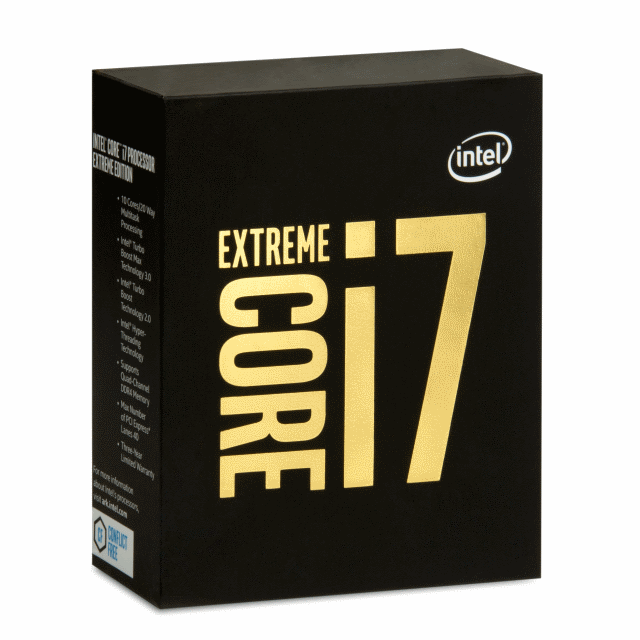
Why is the 6950X so expensive?
This is down to two reasons basically, the perception from end users, especially vocal PC enthusiasts and the place of a 3GHz 10 core, 20 thread part in the stack of Intel’s large range of –E and –EP series processors.
Firstly, American enthusiasts are too used to whole numbers with bias solely placed upon the magic $999 price. Any significant markup above this for a CPU or GPU and that segment of users goes into air raid panic mode.
If you do not believe me, simply enter a tech oriented IRC chat, forum, comment thread or newsgroup and bring up this topic and watch the sparks fly.
Secondly, other developed regions who have a devalued currency compared to the US dollar do not share this view per se as they are used to seeing these flagship processors with a four-digit price.
Although priced at $999 USD RRP, the outgoing 5960X was typically available for $1600 ish Australian dollars including tax street price, despite a direct conversion of the RRP being $1380 taken at 1 USD = 1.38140 AUD.
If we add Australian goods and services tax (10% GST, also known as VA) to 1380 we get $1518 AUD. On top of that, add the distributors markup as well as the reseller’s markup and we get to $1600 ish.
The same rule applies to the new 6950X. $1569 US RRP converts to 2167 AUD, plus tax we get $2383 AUD, plus channel markup and we get to the $2450 AUD street price we have seen for this new processor.
The same applies to the EU market and other newly launched products such as the NVIDIA GEFORCE GTX 1080 graphics card, which sells for 1199 AUD but is 649 US.
It is simply a mind game.
Yes, the 6950X at $US1569 is not priced linearly for its two extra cores above the $999 8 core offering, but their logic is understandable. A $300 difference for more cores would have been more desirable but that may cannibalise sales of both i7s and Xeons.
What did people expect? Another Two more CPU cores for free at $999? Intel already did that going from 6 to 8 core with the caveat of the user getting a lower clock speed. Four cores for free over four years? It does not work like that. Intel does add additional cores to its Xeon parts, two at a time
I don’t approve of what Intel has done, especially for non-US regions but I can understand why they have done this and this is the message I am trying to relay. Many purchasing opinions are made using relative prices and in AUS a $2550 processor ON PAPER looks bad, except for the wealthy.
Intel will definitely have had many meetings, discussions and run their numbers on how to price this part. They may even have an internal formula, it is not a price they pulled out of their arse. Regional pricing and demand make worldwide pricing more complicated as do other related products. If we start putting regional limits on pricing, let’s say the 10 core should be no more than $1300 USD or $1600 AUD then that ruins everything as exchange rates are not 1:1.
Before going into the actual worldwide pricing, I will say this. This is not the first time we have had ‘expensive’ Intel CPUs that exceeded the magic number, at least in AUD. The original Pentium III release of 1999 was specced as a supplement to the Pentium II and not an overall replacement (that would come a year or so later), so those original Pentium III models were priced ABOVE existing Pentium III models in $1000 to $1300 AUD range. It’s nowhere near $2600 for the 6950X but the same mental subjective judgement applies.
What about the other models, not just the 6950X?
For the rest of the stack, the RRP pricing is a bit inconsistent. 5820K to 6800K is $23 versus 5930K to 6850K is $4. There is no way to explain this, both pairs have the same PCIe lanes, cache and general clock range, albeit bumped 100MH, on paper both should have an equal price difference. Just another example of Intel’s clever pricing tactics and strategy. We will post an explanation from Intel when we have it.
We do not foresee any upcoming price cuts for the 2014 Haswell-E processors, Intel no longer does these anyway.
Regional Street Pricing at Launch Time - US, Australia and Europe
Australia, Europe, !and Parts of the US enforce Sales Tax or VAT. For the purposes of this MSRP conversion, I have chosen to ignore it as it just makes the example too complicated.
We have also included the two-year-old, socket compatible and still competitive 4th Gen Haswell-E HEDT parts as well as the current flagship mainstream consumer part the 6th gen 6700K
The purpose of this pricing table is to demonstrate the absolute minimum pricing for a particular region, excluding tax and to give our readers a regional indicator as Intel (and NVIDIA but not AMD) only publicise pricing of Bulk Tray CPUs in US Dollars per 1000 units and not in any regional currency due to exchange rates taxes shipping and demand.
United States
Prices compiled from combination of Microcenter, Newegg and Amazon with the lowest prices recorded as the lowest street price. The problem with Microcenter is they often sell at or below Intel RRP, but this cannot be ignored.
| CPU | Street Price $ USD | Intel MSRP $ USD | Intel MSRP $ USD converted to $ AUD (ex Tax) | Intel MSRP $ USD converted to € EUR (ex Tax) |
|---|---|---|---|---|
| i7-6950X | 1599 | 1569 | 2170 | 1407 |
| i7-6900K | 1099 | 999 | 1383 | 896 |
| i7-5960X | 900 | 999 | 1383 | 896 |
| i7-6850K | 628 | 587 | 813 | 526 |
| i7-5930K | 500 | 583 | 806 | 523 |
| i7-6800K | 400 | 412 | 570 | 370 |
| i7-5820K | 320 | 389 | 538 | 349 |
| i7-6700K | 310 | 339 | 469 | 304 |
2-JUNE-2016. 1 USD = 1.379 AUD, 1 USD= 0.89 EUR
Australia
However for actual real market/street prices such as those found on price matching websites or e-tailer/IT channel resellers, at least for AUS these consumer prices typically are listed included tax.
On launch day using the staticice.com.au price engine, one popular reseller was the only 6950X result at $2540. During writing this story, other the price has gone UP to $2579/$2599 AUD now that stock is starting to arrive at other resellers, the other parts went up as well.
| CPU | Street Price $ AUD |
$ AUD | Intel MSRP $ USD |
|---|---|---|---|
| i7-6950X | 2579 | 1870 | 1569 |
| i7-6900K | 1649 | 1195 | 999 |
| i7-5960X | 1395 | 1011 | 999 |
| i7-6850K | 959 | 698 | 587 |
| i7-5930K | 839 | 608 | 583 |
| i7-6800K | 669 | 485 | 412 |
| i7-5820K | 553 | 401 | 389 |
| i7-6700K | 483 | 350 | 339 |
2-JUNE-2016. 1 USD=1.379 AUD
Europe
We used the geizhals.at price engine for European street pricing, note sales tax may apply to EUR prices and we have listed them as-is from the price engine.
| CPU | Street Price € EUR | € EUR converted to $ USD | Intel MSRP $ USD |
|---|---|---|---|
| i7-6950X | 1737 | 1943 | 1569 |
| i7-6900K | 1125 | 1258 | 999 |
| i7-5960X | 1072 | 1199 | 999 |
| i7-6850K | 662 | 740 | 587 |
| i7-5930K | 598 | 669 | 583 |
| i7-6800K | 465 | 520 | 412 |
| i7-5820K | 397 | 444 | 389 |
| i7-6700K | 340 | 380 | 339 |
2-JUNE 2016. 1 USD = 0.89 EUR
As the older Haswell-E parts fluctuate in price due to supply and demand, they offer better bang for back over their +200MHz newer Broadwell-E siblings based on street pricing
Verdict
Despite the price and other better value options, there will still be a portion of the community who will buy the best of the best despite what the vox populi and reviewers/early adopters recommend.
The 6950X (and its 5960X sibling, plus the rest of the i7-69xx/68xx line) are meant for the top 1%, the ultra-enthusiasts with disposable income. Those complaining about the price were never the target market. In all discussions I (and other media) have had with Intel in the past years, Intel themselves have never meant for the Extreme Edition to be aimed at the mass market, hence the high price. The mass market has affordable, performant and highly overclockable quad core i7 and i5 parts to satisfy their cravings.
While we do not have a sample at launch time, we really don’t need one to give you an evaluation on performance.
Broadwell was intended to be more of a platform evolution, including 14nm Finfet manufacturing process, better graphics,a 3% improvement in Instructions per clock (efficiency), and other minor enhancements throughout the CPU and platform. We discount graphics for the HEDT and Xeon parts involved in this article.
On the High-End DeskTop implementation which we are writing about today, Cache sizes remain the same for the 6 and 8 core parts while the new 10 core part gets an extra 5MB to 25MB to accommodate its extra cores. Improved minimum memory support to DDR-2400 across the board but Haswell-e could already support 2400 in a stable fashion with a suitable motherboard.
Then comes clock speeds. 6950X mirrors the 5960X but adds two more cores. This allows Intel to claim certain large % increases for popular productivity and content creation applications as well as modern multi-threaded games due to the additional cores.
For the new 5th gen 8 and 6 core parts, the 8 core part is 200MHz faster across the board and the 6 core is 2-300MHz Faster across the board, plus the improvements we have mentioned. These are minor improvements well within the safe limits of what Intel is able to achieve through the manufacturing of various processors that meet these specifications.
For those who already own a 4th Gen Haswell-E or even an Ivy Bridge-E and overclock would know that 200MHz is easily achieved ‘with the turn of a knob’ with little impact on stability and temperature , so such spec improvements are meaningless.
The improved parts are relevant to new buyers of the Intel HEDT platform and not to existing owners. Those should wait another two years for Skylake-E or if it is viable the FX enthusiast edition of AMD’s ‘Zen’ Core. Broadwell-E is not meant to be a sought after general upgrade path for Haswell-E owners, unless you have the entry level 5820K and need more cores, which of course is only a BIOS update away as the new processor just drops into the existing X99 motherboard.
Intel has added a few conveniences to this generation which were inevitable due to their presence on their Xeon Siblings. Per-Core overclocking, AVX Ratio Offset, VccU voltage Control and Turbo Boost Max 3.0. Per Core overclocking allows users to extract the most top end performance and efficiency from their chip, AVX Ratio offset finally helps alleviate an issue known to enthusiasts who encounter throttling when running an AVX heavy application such as Prime95 or Linpack, VccU voltage control adds the ability to voltage tweak the Ring Bus or Uncore mainly for extreme liquid nitrogen overclocking and finally Turbo Boost Max 3.0 Technology is a software solution that allows the user to ‘peg’ certain older, likely single threaded applications to a particular faster core so that the application can run and complete faster. Overcoming a limitation that a user can have either single threaded or multi-core performance rather than both.
These features have a minimal overall impact for the product and are included to appease overlocker’s/enthusiasts and because these features are part of the Xeon line anyway. Turbo max 3.0 is a desperate attempt to save face because very high clock speeds are not possible on Intel’s very-multi core parts such as the 8 and 10 compared to their quad-core parts.
Skylake-E (and what will almost definitely be a new socket and new chipset based on the server ‘Purley’ platform) will bring significant CPU and Platform enhancements and get rid of some caveats with the Haswell/Broadwell-E/EP platform. New technologies will also be in the mix such as Intel Optane/3DXrosspoint storage technology, Non-Volatile DIMMs and hopefully, free integrated Thunderbolt 3 within the system chipset.
Despite Intel’s claims, there is not much to see here and dedicate enthusiasts have long settled on the Skylake unlocked K parts with a heavy overclock. Intel is banking on the ever increasing community of content creators, meaning amateur filmmakers, YouTubers, vloggers and streamers who need the multi-core horsepower to render their work in times order of magnitude faster than a quad core part even with a heavy 30% overclock. There is no replacement for displacement. So keen and desperate is Intel that they even had to make up a new buzzword to justify this market segment, ‘mega-taskers’, an evolution of multi-taskers. Something that was the first time I have heard in 25 years of Windows computing.
Professional users such as scientists, engineers, and filmmakers typically use Single or Dual-Xeon powered workstations from a supported OEM vendor such as HP, Lenovo, Dell, and Apple; some of which can have up to 22 cores making Broadwell-E moot for such customers who have no use for overclocking or tweaking.
We have a variety of readers who read our stories. Ultra-enthusiasts have already made up their minds on whether 5th Gen Core i7 Extreme Edition passes the muster, no thanks to the specs for this launch which were stolen and leaked from some unknown source and posted on hardware rumour websites who have zero regards for the law and other publishers; and those who are casual computer users who need to read up on what the latest developments are.
Intel’s latest Extreme Edition is a minor update, typical of the company in recent years leveraging its already existing processor developments. Based on what this i7 Extreme Edition and Mainstream i5 and i7 K-Series unlocked processors are capable of when paired with a high-performance mainboard in the hand of even an amateur overclocker, very high clock speeds are possible much more easily than ever before. This is, even more, evidence that Intel plays it safe when determining the clock speeds for their processor lines in order to maximise revenue, actual chips and to upsell end users to a higher spec processor, even though its lower end parts can overclock way past what their best part is capable of.
Intel has been sticking to its now 10+-year-old 130-150W thermal limit despite introduction to the market of more powerful and efficient air and liquid cooling solutions which can support up to 200-600 Watts depending on the size of the radiator.
Intel has the manufacturing capability to make processors that will amaze and outstand even the harshest of enthusiast critics, but the firm is not willing to accept the burden to make this happen, and is too preoccupied on its bottom line and results for shareholders, as a responsible company should be.
When all an end-user has to do is literately flick a switch and their processor is now running 30% faster that is a clear sign a company is sandbagging and innovation of previous years/decades is lacking.
With Intel now the only game in town, the days when a yearly processor update brought significant new performance or functionality improvements are gone. The firm does not need to do anything drastic engineering wise, which can backfire. Intel has learnt from his previous lessons of trying to do too much too soon. Those days are gone. The days of regular price cuts for processors are long gone too.
Meanwhile, enthusiasts, bathe in the fact that Intel is asking you to pay $1500 US or $2500 AU for their best-unlocked processor and hope, pray that the next AMD FX based on the ZEN core will not be US $999. ZEN is supposed to offer Skylake like performance at what we hope is a lower price. After all, there are some people who despite desiring the best of best, do care about money especially when top end performance computing is getting more expensive year on year.
Other reviewers have got it wrong. The i7-6950X is not an expensive processor compared to other High End Intel CPUs in the firms's product stack. In the past there have been consumer processors in the four digit price range and the 6950X repeats this. Yes on its own it is expensive, especially in Australia but for reviewers to say 'there is no reason to buy this processor' is wrong, as the alternatives with 10 or more cores have caveats such as being locked processors being not suitable for overclockers, even higher price or lower turbo boost clock speeds.
Disclosure
Hardware parts featured in this article may have been provided for review purposes on a sample or loan basis. No vendor has paid us or provided any incentive to feature any supplied products in this article.
Dual Xeon E5 Server - RackCorp.com, Sydney, AUS
5960X CPU, DZ87 noard - Intel Australia
Gigabyte X99 Board - Gigabyte Australia
ASUS X99 Board - ASUS Australia
Corsair DDR4 Memory - Corsair
Crucial DDR4 Memory - Crucial ANZ
